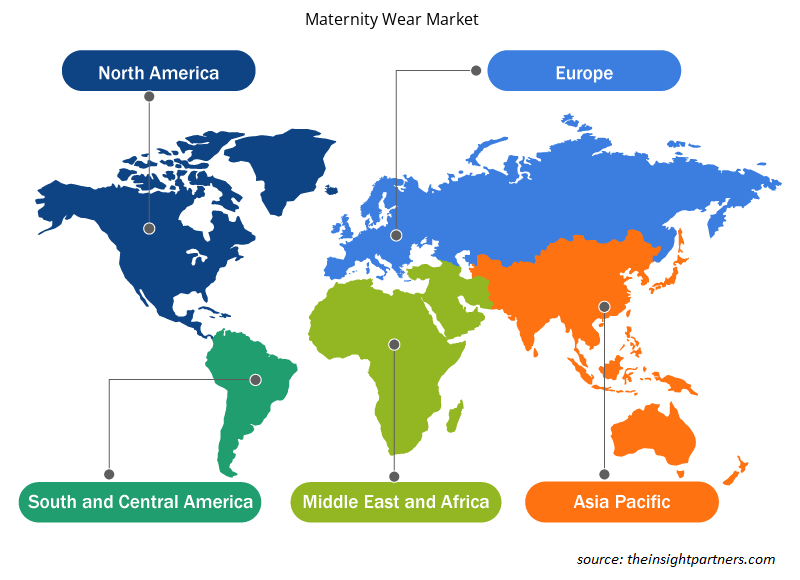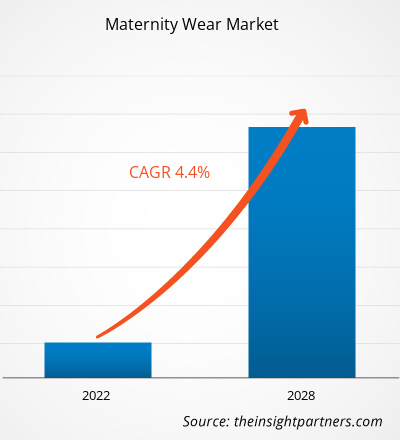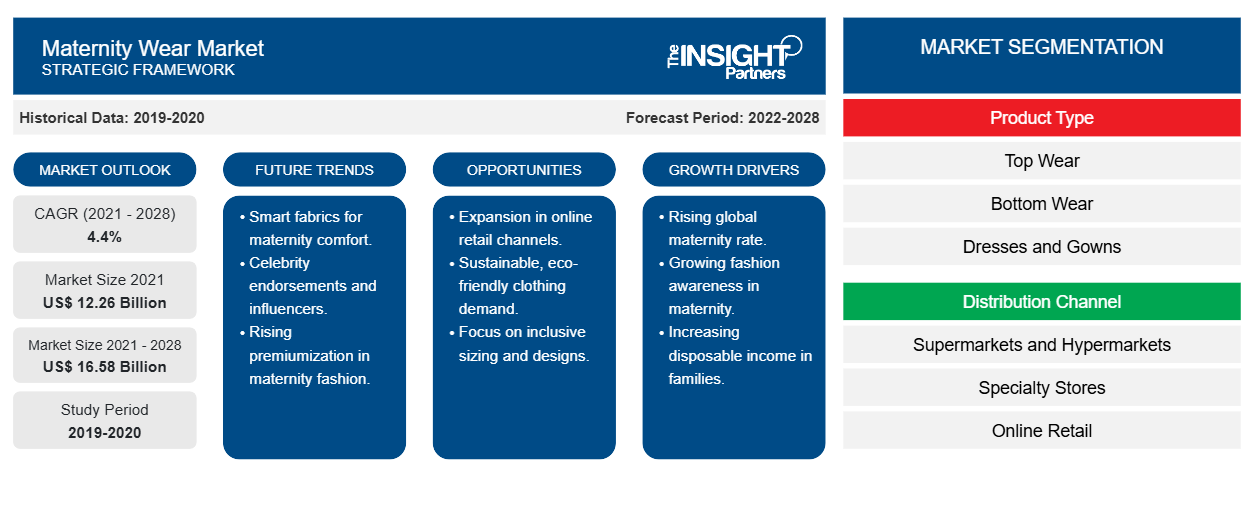Der Markt für Umstandsmode wurde im Jahr 2021 auf 12.257,41 Millionen US-Dollar geschätzt und soll bis 2028 16.578,64 Millionen US-Dollar erreichen; von 2021 bis 2028 wird mit einer durchschnittlichen jährlichen Wachstumsrate von 4,4 % gerechnet.
Umstandsmode hat typischerweise eine lockere, angemessene Passform und enthält Gummizüge, Laschen und dehnbare Stoffe wie Elastan und Spandex, um der Trägerin während der Schwangerschaft zusätzlichen Tragekomfort zu bieten.
Der asiatisch-pazifische Raum hatte 2020 den größten Anteil am weltweiten Markt für Umstandsmode , während Nordamerika im Prognosezeitraum voraussichtlich die höchste durchschnittliche jährliche Wachstumsrate verzeichnen wird. Dem Bericht der Weltbank zufolge sind in den USA durchschnittlich 85 % der schwangeren Frauen berufstätig. Daher steigt die Nachfrage nach Umstandsmode und Übergrößen bei Abendgarderobe im Bereich Abendkleider und Abendkleider. Dies ist ein wichtiger Faktor, der zum Wachstum des Marktes für Umstandsmode in Nordamerika beiträgt.
Auswirkungen der COVID-19-Pandemie auf den Markt für Umstandsmode
Die COVID-19-Pandemie hat viele Branchen negativ beeinflusst, darunter auch die Konsumgüterindustrie. Die Pandemie führte aufgrund von Lockdowns, Geschäftsschließungen und Lieferkettenunterbrechungen zu Betriebsschwierigkeiten. Bekleidungs- und Textileinzelhandel verzeichnete hohe Umsatzeinbußen. Die von Modemarken wie der spanischen Inditex Group und dem schwedischen H&M veröffentlichten Finanzergebnisse verdeutlichten das enorme Ausmaß der Auswirkungen der Pandemie. Darüber hinaus profitierte der E-Commerce langfristig von der Pandemie, da die meisten Online-Käufer den E-Einzelhandel als Option für die Zeit nach der Pandemie betrachten. Darüber hinaus wird erwartet, dass steigende Impfraten, die Wiederbelebung der Produktionsaktivitäten und die Lockerung staatlicher Vorschriften den globalen Markt für Umstandsmode im Prognosezeitraum positiv beeinflussen werden.
Passen Sie diesen Bericht Ihren Anforderungen an
Sie erhalten kostenlos individuelle Anpassungen an jedem Bericht, einschließlich Teilen dieses Berichts oder einer Analyse auf Länderebene, eines Excel-Datenpakets sowie tolle Angebote und Rabatte für Start-ups und Universitäten.
- Holen Sie sich die wichtigsten Markttrends aus diesem Bericht.Dieses KOSTENLOSE Beispiel umfasst eine Datenanalyse von Markttrends bis hin zu Schätzungen und Prognosen.
Markteinblicke
Einführung von Geschäftswachstumsstrategien treibt Marktwachstum voran
Etablierte Akteure auf dem Markt verfolgen verschiedene Strategien, um aktuelle und zukünftige Herausforderungen für die Expansion des Unternehmens zu meistern. So verfolgte Isabella Oliver eine Marktdurchdringungsstrategie, indem sie ein Mietprogramm für Umstandsmode startete, um ihre Reichweite zu verbessern. Am 20. Januar 2020 startete die Marke erneut ein neues Mietprogramm, um zirkulär zu werden und die Lebensdauer von Umstandsmode zu verlängern. Isabella Oliver bot ihren Kundinnen die neue Möglichkeit, ein Kleid, darunter Partykleidung und grundlegende Schwangerschaftsartikel, für zwei Wochen zu mieten und anschließend kostenlos zurückzugeben. Die Marke kümmert sich sogar um die chemische Reinigung. Kundinnen können das Produkt auch kaufen. Die Idee des Mietens von Umstandsmode besteht darin, Kundinnen zu ermutigen, umweltfreundlicher zu leben und die Auswirkungen von Fast Fashion zu beseitigen. Die Produktinnovationen und -durchdringungen führten also zu einer erhöhten Nachfrage nach Umstandsmode. Diese Faktoren treiben das Wachstum des Marktes für Umstandsmode voran.
Einblicke in Vertriebskanäle
Basierend auf den Vertriebskanälen ist der Markt für Umstandsmode in Supermärkte und Hypermärkte, Fachgeschäfte, Online-Einzelhandel und andere unterteilt. Der Online-Einzelhandel wird im Prognosezeitraum voraussichtlich die höchste durchschnittliche jährliche Wachstumsrate verzeichnen. E-Commerce spielte in den ersten Monaten der COVID-19-Pandemie eine wichtige Rolle, da physische Einzelhandelsgeschäfte nicht betrieben werden durften. Während der Lockdowns nutzten die Menschen zunehmend E-Commerce-Plattformen, um lebensnotwendige und nicht lebensnotwendige Produkte zu kaufen. Die Wirtschaftskrise aufgrund des COVID-19-Ausbruchs führte zu einem Rückgang des verfügbaren Einkommens von Frauen. Die Nachfrage nach Umstandsmode wurde jedoch nicht beeinträchtigt. Daher dürfte eine wettbewerbsfähige Preisgestaltung in Zukunft zu einem zentralen Merkmal der gesamten Landschaft werden. Dieser Faktor dürfte das Marktwachstum für den Online-Einzelhandel im Prognosezeitraum potenziell ankurbeln.
Einblicke in Produkttypen
Basierend auf dem Produkttyp ist der Markt für Umstandsmode in Oberbekleidung, Unterbekleidung, Kleider und Abendkleider sowie Unterwäsche segmentiert . Das Segment Oberbekleidung hatte im Jahr 2020 einen größeren Marktanteil, und das Segment Kleider und Abendkleider wird im Prognosezeitraum voraussichtlich eine höhere CAGR verzeichnen. Umstandsoberbekleidung besteht aus formeller Kleidung und Freizeitkleidung. Darüber hinaus steigt die Nachfrage nach formeller Umstandsmode aufgrund der zunehmenden Zahl berufstätiger Frauen. Formelle Umstandsoberbekleidung besteht aus Kurtis, Blusen, Trägerkleidern aus weichem Material, Blazern und Trenchcoats mit zwei Lagen. Freizeitkleidung umfasst Tuniken, Maxikleider und übergroße Sweatshirts und T-Shirts. Umstandsmode wird aus den hochwertigsten Stoffen aus natürlichen und bequemen Materialien wie Baumwolle, Modal und Bambus hergestellt , da sie weich ist und eine gleichmäßige Atmung ermöglicht. Schwangere Frauen neigen dazu, das Material entsprechend den saisonalen Veränderungen auszuwählen. Im Sommer bevorzugen sie wärmeabweisende Leinenstoffe für eine gute Luftzirkulation, während im Winter warme Wollmäntel bevorzugt werden, um Kälte vorzubeugen.
Einige Akteure auf dem Markt für Umstandsmode sind Gap Inc, Seraphine, Isabella Oliver, H and M Hennes and Mauritz AB, Brunelli and Co SRL, Mothercare, Boob Design, SHAICO Fashion Pvt. Ltd, Pink Blush Maternity und Organic & More.
Regionale Einblicke in den Markt für Umstandsmode
Die regionalen Trends und Faktoren, die den Markt für Umstandsmode im Prognosezeitraum beeinflussen, wurden von den Analysten von Insight Partners ausführlich erläutert. In diesem Abschnitt werden auch Marktsegmente und Geografie für Umstandsmode in Nordamerika, Europa, im asiatisch-pazifischen Raum, im Nahen Osten und Afrika sowie in Süd- und Mittelamerika erörtert.

- Erhalten Sie regionale Daten zum Markt für Umstandsmode
Umfang des Marktberichts für Umstandsmode
| Berichtsattribut | Details |
|---|---|
| Marktgröße im Jahr 2021 | 12,26 Milliarden US-Dollar |
| Marktgröße bis 2028 | 16,58 Milliarden US-Dollar |
| Globale CAGR (2021 - 2028) | 4,4 % |
| Historische Daten | 2019-2020 |
| Prognosezeitraum | 2022–2028 |
| Abgedeckte Segmente | Nach Produkttyp
|
| Abgedeckte Regionen und Länder | Nordamerika
|
| Marktführer und wichtige Unternehmensprofile |
|
Marktteilnehmerdichte: Der Einfluss auf die Geschäftsdynamik
Der Markt für Umstandsmode wächst rasant, angetrieben von der steigenden Nachfrage der Endverbraucher aufgrund von Faktoren wie sich entwickelnden Verbraucherpräferenzen, technologischen Fortschritten und einem größeren Bewusstsein für die Vorteile des Produkts. Mit steigender Nachfrage erweitern Unternehmen ihr Angebot, entwickeln Innovationen, um die Bedürfnisse der Verbraucher zu erfüllen, und nutzen neue Trends, was das Marktwachstum weiter ankurbelt.
Die Marktteilnehmerdichte bezieht sich auf die Verteilung der Firmen oder Unternehmen, die in einem bestimmten Markt oder einer bestimmten Branche tätig sind. Sie gibt an, wie viele Wettbewerber (Marktteilnehmer) in einem bestimmten Marktraum im Verhältnis zu seiner Größe oder seinem gesamten Marktwert präsent sind.
Die wichtigsten Unternehmen auf dem Markt für Umstandsmode sind:
- Gap Inc
- Seraphine
- Isabella Oliver
- H & M Hennes und Maurits
- Brunelli & Co. SRL
Haftungsausschluss : Die oben aufgeführten Unternehmen sind nicht in einer bestimmten Reihenfolge aufgeführt.

- Überblick über die wichtigsten Akteure auf dem Markt für Umstandsmode
Bericht-Spotlights
- Fortschrittliche Branchentrends auf dem Markt für Umstandsmode helfen den Akteuren bei der Entwicklung wirksamer langfristiger Strategien
- In Industrie- und Entwicklungsländern angewandte Strategien für Unternehmenswachstum
- Quantitative Analyse des Marktes für Umstandsmode von 2019 bis 2028
- Schätzung der weltweiten Nachfrage nach Milchzutaten
- Porters Fünf-Kräfte-Analyse zur Veranschaulichung der Wirksamkeit von Käufern und Lieferanten in der Branche
- Aktuelle Entwicklungen zum Verständnis des wettbewerbsorientierten Marktszenarios
- Markttrends und -aussichten sowie Faktoren, die das Wachstum des Marktes für Umstandsmode vorantreiben und bremsen
- Unterstützung im Entscheidungsprozess durch Aufzeigen von Marktstrategien, die das kommerzielle Interesse untermauern und zum Marktwachstum führen
- Die Größe des Marktes für Umstandsmode an verschiedenen Knotenpunkten
- Detaillierte Übersicht und Segmentierung des Marktes sowie der Dynamik der Umstandsmodebranche
- Größe des Marktes für Umstandsmode in verschiedenen Regionen mit vielversprechenden Wachstumschancen
- Historische Analyse (2 Jahre), Basisjahr, Prognose (7 Jahre) mit CAGR
- PEST- und SWOT-Analyse
- Marktgröße Wert/Volumen – Global, Regional, Land
- Branchen- und Wettbewerbslandschaft
- Excel-Datensatz
Aktuelle Berichte
Verwandte Berichte
Erfahrungsberichte
Grund zum Kauf
- Fundierte Entscheidungsfindung
- Marktdynamik verstehen
- Wettbewerbsanalyse
- Kundeneinblicke
- Marktprognosen
- Risikominimierung
- Strategische Planung
- Investitionsbegründung
- Identifizierung neuer Märkte
- Verbesserung von Marketingstrategien
- Steigerung der Betriebseffizienz
- Anpassung an regulatorische Trends





















 Kostenlose Probe anfordern für - Markt für Umstandsmode
Kostenlose Probe anfordern für - Markt für Umstandsmode